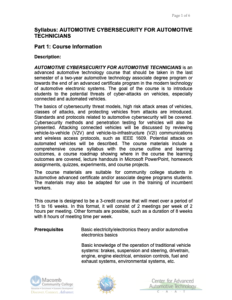Automotive Cybersecurity for Automotive Technicians

Description:
This Automotive Cybersecurity for Automotive Technicians course introduces students to "the potential threats of cyber-attacks on vehicles, especially connected and automated vehicles." Topics covered include: Understanding Threat Models, Bus Protocols & Vehicle Communication, Automotive Electronics and ECUs, Attacking Vehicles, Defining Frameworks for Cybersecurity in Vehicles, Attacking Connected/Automated Vehicles, and Protecting Vehicles from Attacks.
Contents:
Course materials include a syllabus, experiments, projects, and seven lectures that each feature an associated quiz and homework assignment.
The 7-page syllabus orients students to the course and includes the following sections: Course Information, Course Learning Outcomes, Course Topics and Roadmap, and Grading and Assessment.
The 5-page Course Experiments document includes five experiments that provide students with hands-on experience related to course material. Each experiment includes the following sections: Lab Main Purpose, Lab Description, Lab Outline, List of Required Materials.
The Lectures folder contains seven PowerPoint presentations, each dedicated to one of the course topics. Every lecture has an associated homework document and quiz that can be located in the corresponding folder by topic number.
Below is a list of the files contained within the .zip attachment. The size of each file is included in parenthesis.
Automotive_Cybersecurity_Course (34 files, 25.9 MB)
- Course Syllabus (3 files, 279 KB)
- Syllabus: Automotive Cybersecurity for Automotive Technicians (Kettering, Cybersecurity Course Syllabus.docx 264 KB)
- Experiments (2 files, 37 KB)
- Course Experiments (Course Experiments.docx 31 KB)
- Home Work (9 files, 160 KB)
- Homework - Understanding Threat Models (HW - Topic 1, questions.docx 13 KB)
- Homework - Bus Protocols & Vehicle Communication (HW - Topic 2, questions.docx 12 KB)
- Homework - Automotive electronics and ECUs (HW - Topic 3, questions.docx 12 KB)
- Homework - Attacking vehicles (HW - Topic 4, questions.docx 14 KB)
- Homework - Defining Frameworks for Cybersecurity in Vehicles (HW - Topic 5, questions.docx 14 KB)
- Homework - Attacking Connected/automated vehicles (HW - Topic 6, questions.docx 13 KB)
- Homework - Protecting vehicles from attacks (HW - Topic 7, questions.docx 12 KB)
- (READ ME.docx 14 KB)
- Lectures (8 files, 24.5 MB)
- Understanding Threat Models: Identify areas with the highest risk components (1 - Identify areas with the highest risk components.ppt 1.3 MB)
- Bus Protocols & Vehicle Communication: CAN bus and diagnostic link connector (DLC) (2 - Review of Bus Protocols & Vehicle Communication.ppt 3 MB)
- Automotive electronics and ECUs: Introduction to ECUs, software, and firmware (3 - Automotive electronics and ECUs.ppt 4.8 MB)
- Attacking vehicles: Classes of attack vectors (4 - Attacking vehicles.ppt 5.3 MB)
- Defining Frameworks for Cybersecurity in Vehicles: J3061 (5 - Defining Frameworks for Cybersecurity in Vehicles.ppt 802 KB)
- Attacking Connected/automated vehicles: V2V and V2I communication (6 - Attacking Connected automated vehicles.ppt 5.1 MB)
- Protecting Vehicles from Attacks: Cybersecurity protection Methods (7 - Protecting vehicles from attacks.ppt 4.1 MB)
- Projects (2 files, 799 KB)
- Course Projects (Course Projects.docx 791 KB)
- Quizzes (9 files, 160 KB)
- Quiz - Understanding Threat Models (Quiz - Topic 1, questions.docx 13 KB)
- Quiz - Bus Protocols & Vehicle Communication (Quiz - Topic 2, questions.docx 13 KB)
- Quiz - Automotive electronics and ECUs (Quiz - Topic 3, questions.docx 12 KB)
- Quiz - Attacking vehicles (Quiz - Topic 4, questions.docx 14 KB)
- Quiz - Defining Frameworks for Cybersecurity in Vehicles (Quiz - Topic 5, questions.docx 14 KB)
- Quiz - Attacking Connected/automated vehicles (Quiz - Topic 6, questions.docx 13 KB)
- Quiz - Protecting vehicles from attacks (Quiz - Topic 7, questions.docx 12 KB)
- (READ ME.docx)
About this Resource


Comments